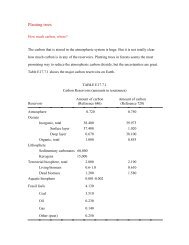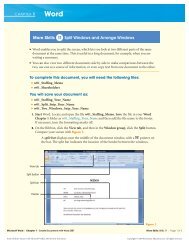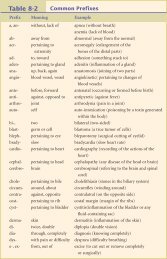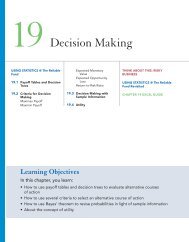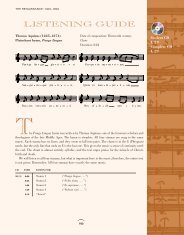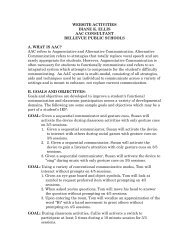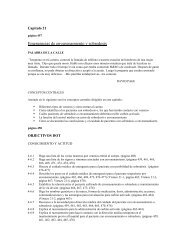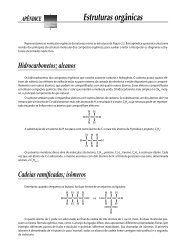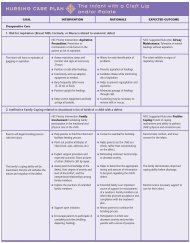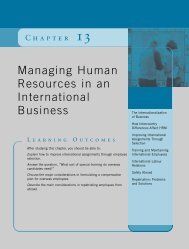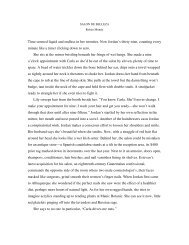chapter
chapter
chapter
You also want an ePaper? Increase the reach of your titles
YUMPU automatically turns print PDFs into web optimized ePapers that Google loves.
194 Unit Three Forces Within<br />
Evidence: Fossils Match<br />
Across the Seas<br />
Although Wegener was intrigued by the jigsaw fit of<br />
the continental margins that lie on opposite sides of the<br />
Atlantic, he at first thought the idea of a mobile Earth<br />
improbable. Not until he came across an article citing<br />
fossil evidence for the existence of a land bridge connecting<br />
South America and Africa did he begin to take<br />
his own idea seriously. Through a search of the literature,<br />
Wegener learned that most paleontologists were in<br />
agreement that some type of land connection was needed<br />
to explain the existence of identical fossils on the<br />
widely separated landmasses.<br />
Mesosaurus. To add credibility to his argument for<br />
the existence of the supercontinent of Pangaea, Wegener<br />
cited documented cases of several fossil organisms<br />
that had been found on different landmasses but that<br />
could not have crossed the vast oceans presently separating<br />
the continents. The classic example is Mesosaurus,<br />
a presumably aquatic, snaggle-toothed reptile<br />
whose fossil remains are limited to eastern South<br />
America and southern Africa (Figure 7.4). If Mesosaurus<br />
had been able to swim well enough to cross the<br />
vast South Atlantic Ocean, its remains should be more<br />
widely distributed. As this is not the case, Wegener<br />
argued that South America and Africa must have<br />
been joined somehow.<br />
How did scientists explain the discovery of identical<br />
fossil organisms separated by thousands of kilometers<br />
of open ocean? The idea of land bridges was the<br />
most widely accepted solution to the problem of migration<br />
(Figure 7.5). We know, for example, that dur-<br />
BOX 7.1<br />
UNDERSTANDING EARTH:<br />
The Breakup of a Supercontinent<br />
Agreat deal of evidence<br />
has been<br />
gathered to support the fact that Alfred<br />
Wegener’s supercontinent of Pangaea<br />
began to break apart about 200 million<br />
years ago as he had originally suggested<br />
(Figure 7.A, part A). An important<br />
consequence of this continental rifting<br />
was the creation of a “new” ocean<br />
basin, the Atlantic. As you can see in<br />
Figure 7.A, part B, the rifting that eventually<br />
resulted in the Atlantic basin occurred<br />
over an extended period of time.<br />
The first rift developed between North<br />
America and Africa and generated<br />
great volumes of Jurassic-age basalts.<br />
These basalts are present as weathered<br />
flows and sills along the Eastern<br />
Seaboard of the United States but primarily<br />
buried beneath rocks that form<br />
the continental shelf. Radiometric dating<br />
of this material indicates that rifting<br />
began in various stages between 200<br />
million and 165 million years ago. This<br />
time span can be used as the birth date<br />
for this section of the North Atlantic.<br />
Rifting that formed the South Atlantic<br />
began about 130 million years ago<br />
near the tips of what are now Africa and<br />
South America. As this rift propagated<br />
northward, it gradually opened the<br />
South Atlantic (compare Figure 7.A,<br />
parts B and C). Continued rifting of the<br />
southern landmass of Gondwanaland<br />
sent India on a northward journey. By<br />
the early Cenozoic, about 50 million<br />
ing the most recent glacial period, the lowering of sea<br />
level allowed animals to cross the narrow Bering Strait<br />
between Asia and North America. Was it possible, then,<br />
that one or more land bridges once connected Africa<br />
and South America? We are now quite certain that land<br />
bridges of this magnitude did not exist, for their remnants<br />
should still lie below sea level. But they are<br />
nowhere to be found.<br />
Present-Day Organisms. In his book, Wegener also<br />
cited the distribution of present-day organisms as<br />
evidence to support the concept of drifting continents.<br />
For example, modern organisms with similar ancestries<br />
clearly had to evolve in isolation during the last<br />
few tens of millions of years. Most obvious of these<br />
are the Australian marsupials, which have a direct<br />
fossil link to the marsupial opossums found in the<br />
Americas.<br />
Evidence: Rock Types<br />
and Structures Match<br />
Anyone who has worked a picture puzzle knows that,<br />
in addition to the pieces fitting together, the picture<br />
must also be continuous. The picture that must match<br />
in the Continental Drift Puzzle is one of rock types and<br />
mountain belts. If the continents were once together to<br />
form Pangaea, the rocks found in a particular region on<br />
one continent should closely match in age and type<br />
those in adjacent positions on the adjoining continent.<br />
Such evidence exists in the form of several mountain<br />
belts that terminate at one coastline, only to reappear<br />
on a landmass across the ocean. For instance, the<br />
mountain belt that includes the Appalachians trends<br />
years ago, Australia began to separate<br />
from Antarctica, and the South Atlantic<br />
had emerged as a full-fledged ocean<br />
(Figure 7.A, part D).<br />
A modern map (Figure 7.A, part E)<br />
shows that India eventually collided<br />
with Asia, an event that began about<br />
45 million years ago and created the<br />
Himalayas as well as the Tibetan Highlands.<br />
About the same time, the separation<br />
of Greenland from Eurasia<br />
completed the breakup of the northern<br />
landmass (Laurasia). Also, notice the recent<br />
formation of the Baja Peninsula<br />
along with the Gulf of California. This<br />
event began less than 10 million years<br />
ago.




